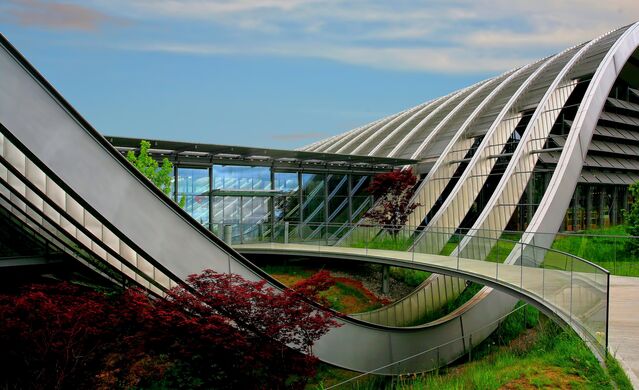Environment
What We Like About Built and Natural Spaces
Psychological dimensions that shape our responses to the environment.
Posted October 17, 2021 Reviewed by Lybi Ma
Key points
- Preferences for interior spaces are rooted in three psychological dimensions—coherence, fascination, and hominess.
- Judgments of buildings and natural landscapes indicate these three qualities also mediate aesthetic responses to exterior spaces.
- What counts as a homey environment differs depending on whether immediate surroundings are natural or human-made.

This post was co-authored with Adam Weinberger, Ph.D.
Scientists, philosophers, and designers have long tried to understand the impact of our surrounding environment on our psychological states. Aristotle, for instance, explored the nature of “material” causes that give rise to different human responses.
Contemporary research in environmental and architectural aesthetics follows this tradition. Are there principles that govern a person’s aesthetic experiences of the environment? Do psychological responses generalize across different kinds of environments or contexts?
Psychological dimensions of interior spaces
We (Coburn et al., 2020; Vartanian et al., 2021) found that people’s preferences for architectural interior spaces are rooted in three psychological dimensions: coherence (i.e., analytic judgments about organization and comprehension of a scene), fascination (i.e., a scene’s informational richness that generates interest), and hominess (i.e., how personal a space feels).
Recently, we asked if these dimensions explain aesthetic responses to outside environments (Weinberger et al., 2021). Do people respond differently when encountering built or natural spaces? Are people more consistent in their preference for natural landscapes than for human-made artifacts?
To address these questions, we asked a large group of people to make online judgments of images of building exteriors and natural landscapes on the same psychological dimensions assessed in the original study by Coburn and colleagues (2020). We used network science methods to analyze their responses.
Buildings vs. natural landscapes
First, as expected, we found that people agreed more often when considering landscapes than when considering buildings. Consistent with other reports (Vessel et al., 2018), people share taste for natural objects, perhaps because of preferences sculpted by evolution in a way that does not apply to human-made artifacts. Preferences for buildings are more likely influenced by a person’s experiences, their individual and cultural histories.
We also found that people’s responses to buildings were explained by the same underlying dimensions we identified for interior spaces: coherence, fascination, and hominess. Corollaries of coherence and fascination have been regarded as important components of aesthetic experience for decades, but hominess has thus far been understudied. This dimension in an entirely new set of images confirms its importance to the aesthetic experiences of our environments.
We found similar underlying dimensions for natural environments as well. Fascination, coherence, and hominess continued to underlie responses, although coherence and hominess combined in a way that was not true for buildings.
Finally, previous work by Coburn and colleagues relied on images curated carefully by architects. Here we used a more diverse set of spaces. The consistency of the importance of coherence, fascination, and hominess suggests that these are core responses to our spatial environment.
The relativity of hominess
We did, however, also find some differences in psychological responses for built and natural spaces. Most intriguingly, hominess was associated with greater naturalness in the built environments, while homier natural landscapes were more ordered. This distinction suggests that people prefer natural objects with a touch of human ordering, and human-made objects that look natural.
Many have claimed that nature is relaxing or comforting. It is probably not right to think of all-natural environments as such. For example, a person placed in the middle of an ocean or deep in a jungle is unlikely to be soothed or comforted by nature. Rather, to be comforting, nature needs to be somewhat ordered—a clean, calm beach or manicured campground has a level of organization that makes these environments hospitable.
Broadening our understanding of how people experience their surrounding environments, with careful consideration of differences across contexts, may assist designers and architects to construct spaces that produce desirable responses in their inhabitants.
References
Coburn, A., Vartanian, O., Kenett, Y. N., Nadal, M., Hartung, F., Hayn-Leichsenring, G., ... & Chatterjee, A. (2020). Psychological and neural responses to architectural interiors. Cortex, 126, 217-241. https://doi.org/10.1016/j.cortex.2020.01.009.
Vartanian, O., Navarrete, G., Palumbo, L., & Chatterjee, A. (2021). Individual differences in preference for architectural interiors. Journal of Environmental Psychology, 77, 101668. https://doi.org/10.1016/j.jenvp.2021.101668.
Vessel, E. A., Maurer, N., Denker, A. H., & Starr, G. G. (2018). Stronger shared taste for natural aesthetic domains than for artifacts of human culture. Cognition, 179, 121-131. https://doi.org/10.1016/j.cognition.2018.06.009.
Weinberger, A. B., Christensen, A. P., Coburn, A., & Chatterjee, A. (2021). Psychological responses to buildings and natural landscapes. Journal of Environmental Psychology, 77, 101676. https://doi.org/10.1016/j.jenvp.2021.101676.




